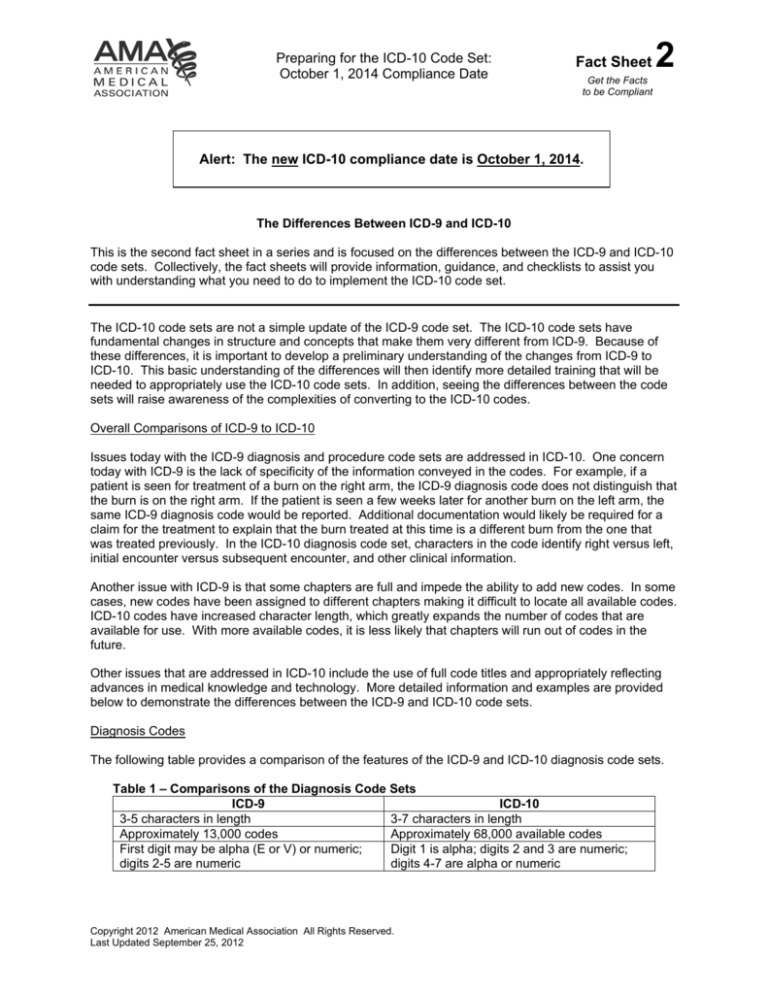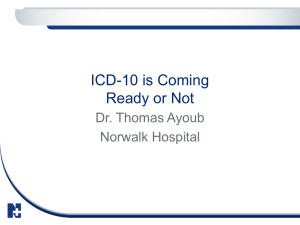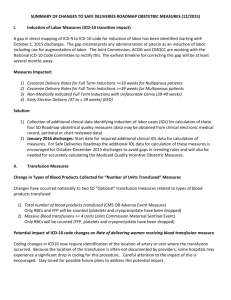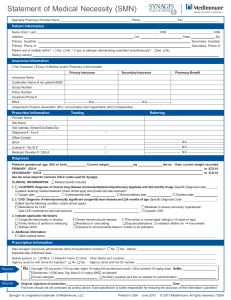
Preparing for the ICD-10 Code Set:
October 1, 2014 Compliance Date
Fact Sheet
2
Get the Facts
to be Compliant
Alert: The new ICD-10 compliance date is October 1, 2014.
The Differences Between ICD-9 and ICD-10
This is the second fact sheet in a series and is focused on the differences between the ICD-9 and ICD-10
code sets. Collectively, the fact sheets will provide information, guidance, and checklists to assist you
with understanding what you need to do to implement the ICD-10 code set.
The ICD-10 code sets are not a simple update of the ICD-9 code set. The ICD-10 code sets have
fundamental changes in structure and concepts that make them very different from ICD-9. Because of
these differences, it is important to develop a preliminary understanding of the changes from ICD-9 to
ICD-10. This basic understanding of the differences will then identify more detailed training that will be
needed to appropriately use the ICD-10 code sets. In addition, seeing the differences between the code
sets will raise awareness of the complexities of converting to the ICD-10 codes.
Overall Comparisons of ICD-9 to ICD-10
Issues today with the ICD-9 diagnosis and procedure code sets are addressed in ICD-10. One concern
today with ICD-9 is the lack of specificity of the information conveyed in the codes. For example, if a
patient is seen for treatment of a burn on the right arm, the ICD-9 diagnosis code does not distinguish that
the burn is on the right arm. If the patient is seen a few weeks later for another burn on the left arm, the
same ICD-9 diagnosis code would be reported. Additional documentation would likely be required for a
claim for the treatment to explain that the burn treated at this time is a different burn from the one that
was treated previously. In the ICD-10 diagnosis code set, characters in the code identify right versus left,
initial encounter versus subsequent encounter, and other clinical information.
Another issue with ICD-9 is that some chapters are full and impede the ability to add new codes. In some
cases, new codes have been assigned to different chapters making it difficult to locate all available codes.
ICD-10 codes have increased character length, which greatly expands the number of codes that are
available for use. With more available codes, it is less likely that chapters will run out of codes in the
future.
Other issues that are addressed in ICD-10 include the use of full code titles and appropriately reflecting
advances in medical knowledge and technology. More detailed information and examples are provided
below to demonstrate the differences between the ICD-9 and ICD-10 code sets.
Diagnosis Codes
The following table provides a comparison of the features of the ICD-9 and ICD-10 diagnosis code sets.
Table 1 – Comparisons of the Diagnosis Code Sets
ICD-9
ICD-10
3-5 characters in length
3-7 characters in length
Approximately 13,000 codes
Approximately 68,000 available codes
First digit may be alpha (E or V) or numeric;
Digit 1 is alpha; digits 2 and 3 are numeric;
digits 2-5 are numeric
digits 4-7 are alpha or numeric
Copyright 2012 American Medical Association All Rights Reserved.
Last Updated September 25, 2012
Preparing for the ICD-10 Code Set:
October 1, 2014 Compliance Date
Limited space for adding new codes
Lacks detail
Lacks laterality
Fact Sheet
2
Get the Facts
to be Compliant
Flexible for adding new codes
Very specific
Has laterality (i.e., codes identifying right vs.
left)
In the ICD-10 diagnosis code set, the alpha characters are not case sensitive. The following examples
show a comparison of the formats of the ICD-9 and ICD-10 diagnosis codes. You can see the use of
alpha characters and longer codes in ICD-10.
ICD-9 Diagnosis Code
382.9 Acute otitis media
540.9 Acute appendicitis
780.01 Coma
ICD-10 Diagnosis Code
B01.2
Varicella pneumonia
K21.0
Gastro-esophageal reflux disease with esophagitis
O30.003 Twin pregnancy, unspecified, third trimester
The expanded number of characters of the ICD-10 diagnosis codes provides greater specificity to identify
disease etiology, anatomic site, and severity.
ICD-10 Code Structure:
Characters 1-3 – Category
Characters 4-6 – Etiology, anatomic site, severity, or other clinical detail
Characters 7 – Extension
The following example shows the more detailed information gained through the added characters.
S52 Fracture of forearm
S52.5 Fracture of lower end of radius
S52.52 Torus fracture of lower end of radius
S52.521 Torus fracture of lower end of right radius
S52.521A Torus fracture of lower end of right radius, initial encounter for closed fracture
In the above example, S52 is the category. The fourth and fifth characters of “5” and “2” provide
additional clinical detail and anatomic site. The sixth character in this example indicates laterality, i.e.,
right radius. The seventh character, “A”, is an extension that provides additional information, which
means “initial encounter” in this example.
The example of the forearm fracture also demonstrates the use of the full code titles, which was not the
format in the ICD-9 diagnosis code set. The following is a comparison of ICD-9 and ICD-10 diagnoses
demonstrating the use of full code titles.
ICD-9 Diagnosis Codes
157 Malignant neoplasm of pancreas
157.0 Head of pancreas
157.1 Body of pancreas
157.2 Tail of pancreas
157.3 Pancreatic duct
157.4 Islets of Langerhans
157.8 Other specified sites of pancreas
157.9 Pancreas, part unspecified
ICD-10 Diagnosis Codes
S52 Fracture of forearm
S52.5 Fracture of lower end of radius
S52.5 Fracture of lower end of radius
S52.521 Torus fracture of lower end of right radius
S52.521A Torus fracture of lower end of right
radius, initial encounter for closed fracture
The ICD-10 diagnosis code set also expands on the use of combination codes. Combination codes are a
single code that can be used to classify 1) two diagnoses, or 2) a diagnosis with an associated secondary
Copyright 2012 American Medical Association All Rights Reserved.
Last Updated September 25, 2012
Preparing for the ICD-10 Code Set:
October 1, 2014 Compliance Date
Fact Sheet
2
Get the Facts
to be Compliant
process or a diagnosis with an associated complication. Combination codes allow for the reporting of a
single code to express multiple elements of the diagnosis. The following are examples illustrating
combination codes in ICD-10 versus ICD-9 diagnosis codes.
ICD-9 Diagnosis Codes
415.0 Acute cor pulmonale
And
415.12 Septic pulmonary embolism
707.06 Pressure ulcer, ankle
And
707.21 Pressure ulcer stage I
ICD-10 Diagnosis Codes
I26.01 Septic pulmonary embolism with
acute cor pulmonale
L89.501 Pressure ulcer of unspecified ankle,
stage I
The increased specificity of the ICD-10 codes is more flexible, which means that emerging diseases can
be quickly incorporated. The higher level of detail in the codes provides the ability to more precisely code
the diagnosis. As with ICD-9, ICD-10 codes are to be reported at the highest level of detail possible
within the code structure. ICD-10 reflects advances in medicine and medical technology making the code
set more relevant to today’s understanding of diagnoses. ICD-10 also provides an improved ability to
measure health care services and conduct public health surveillance.
Procedure Codes
ICD-10-PCS will not replace the Current Procedural Terminology (CPT ® ) and Healthcare Common
Procedure Coding System (HCPCS) code sets for reporting services and procedures in outpatient and
office settings.
The following table is a comparison of the differences in the features between the ICD-9 and ICD-10
procedure code sets.
Table 2 – Comparisons of Procedure Codes
ICD-9
3-4 numbers in length
Approximately 3,000 codes
Based on outdated technology
Limited space for adding new codes
Lacks detail
Lacks laterality
Generic terms for body parts
Lacks descriptions of methodology and
approach for procedures
Lacks precision to adequately define
procedures
®
ICD-10
7 alpha-numeric characters in length
Approximately 87,000 available codes
Reflects current usage of medical terminology
and devices
Flexible for adding new codes
Very specific
Has laterality
Detailed descriptions for body parts
Provides detailed descriptions of methodology
and approach for procedures
Precisely defines procedures with detail
regarding body part, approach, any device
used, and qualifying information
CPT is a registered trademark of the American Medical Association
Copyright 2012 American Medical Association All Rights Reserved.
Last Updated September 25, 2012
Preparing for the ICD-10 Code Set:
October 1, 2014 Compliance Date
Fact Sheet
2
Get the Facts
to be Compliant
The following are examples showing the different formats of the procedure codes.
ICD-9 Procedure Code
39.50 Angioplasty
39.31 Suture of artery
47.01 Laparoscopic
appendectomy
ICD-10 Diagnosis Code
0DN90ZZ Release of duodenum, open approach
0FB03ZX Excision of liver, percutaneous approach, diagnostic
02PS0CZ Removal, extraluminal device from pulmonary vein,
right, open
The alpha characters in the ICD-10 procedure code set are not case sensitive. The letters O and I are
not used to avoid confusion with the numbers 0 and 1.
The additional characters in the ICD-10 procedure code set allows for identifying the body system, root
operation, body part, approach, and device involved in the procedure. The code structure in the Medical
and Surgical section is:
Character
1
2
Definition
Name of
Section
3
Body
System
Root
Operation
4
Body
Part
5
Approach
6
Device
7
Qualifier
The following example identifies the meaning of each character of the code.
Right knee joint replacement = 0SRD0JZ
0 = Medical and Surgical Section
S = Lower Joints
R = Replacement
D = Knee Joint, Right
0 = Open
J = Synthetic Substitute
Z = No Qualifier
As with the ICD-10 diagnosis code set, there are many benefits to the ICD-10 procedure code set. It
provides greater detail to describe complex medical procedures and describes precisely what was done
to the patient. There is plenty of space to add new procedures. It uses current medical terminology. The
codes follow a logical structure. There is standardized terminology, which means that each term has the
exact same meaning across the code set. The codes also have a multi-axial structure, meaning that
each code character has the same meaning within procedure sections and across the code set where
possible.
Conclusion
The ICD-10 code sets are not simply increased and renumbered ICD-9 code sets. The move to ICD-10
will not be easy. The ICD-10 code sets include greater detail, changes in terminology, and expanded
concepts for injuries, laterality, and other related factors. The complexity of ICD-10 provides many
benefits because of the increased level of detail conveyed in the codes. The complexity also underscores
the need to be adequately trained on ICD-10 in order to fully understand reporting changes that will come
with the new code sets.
Visit the AMA’s website for more resources for
implementing the ICD-10 code set.
www.ama-assn.org/go/ICD-10
Copyright 2012 American Medical Association All Rights Reserved.
Last Updated September 25, 2012






